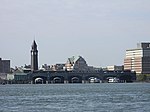1900 Hoboken Docks fire

The 1900 Hoboken Docks fire occurred on June 30, 1900, and killed at least 326 people in and around the Hoboken, New Jersey piers of the Norddeutscher Lloyd (NDL) shipping company. The piers were in New York Harbor, at the foot of 3rd and 4th Streets in Hoboken, across the North River (Hudson River) from Manhattan in New York City. The area, a few blocks north of Hoboken Terminal, is now mostly part of the Hudson River, without docks: a waterfront bicycle path lines it.The fire began when cotton bales stored on NDL's southernmost wharf caught fire, and winds carried the flames to nearby barrels of volatile liquids, such as turpentine and oil, which exploded in rapid succession. It burned NDL's Hoboken piers to the waterline, consumed or gutted nearby warehouses, gutted three of NDL's major transatlantic liners, and damaged or destroyed nearly two dozen smaller craft. Most of the victims were seamen and other workers but included women visiting one of the ships.
Excerpt from the Wikipedia article 1900 Hoboken Docks fire (License: CC BY-SA 3.0, Authors, Images).1900 Hoboken Docks fire
Hoboken Newport Walkway – Hudson River Waterfront Walkway,
Geographical coordinates (GPS) Address Nearby Places Show on map
Geographical coordinates (GPS)
| Latitude | Longitude |
|---|---|
| N 40.7387 ° | E -74.0268 ° |
Address
Hoboken Newport Walkway – Hudson River Waterfront Walkway
Hoboken Newport Walkway – Hudson River Waterfront Walkway
07030
New Jersey, United States
Open on Google Maps








